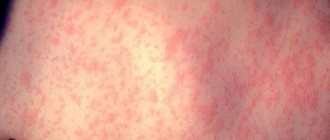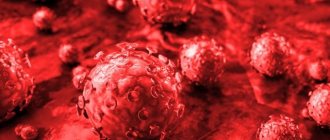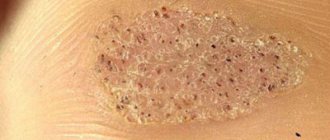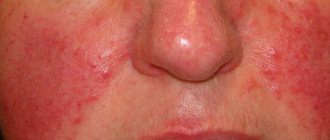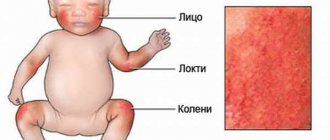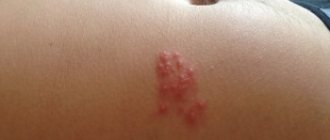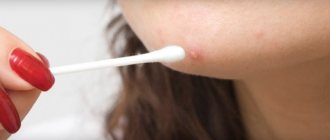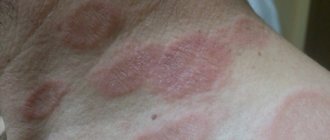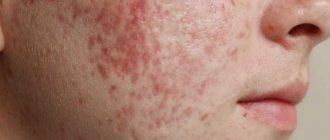Vitiligo is a disease characterized by depigmentation of areas of the skin. Areas with impaired melanin synthesis appear light or completely white. Vitiligo in children occurs with the same frequency as in the adult population, but in newborns cases of the disease are more rare than in adolescents, which is caused by the gradual formation of skin tone.
Features and symptoms in children
The main feature of the disease is that it does not appear on its own. It is preceded by various factors:
- Vitiligo in a child can develop after an illness, and can also be a consequence of severe stress or sunburn;
- about 10% of cases of pigmentation disorders are attributed to hereditary etiology;
- various pathologies in the body: dysfunction of the gastrointestinal tract and neurocirculatory dystonia;
- as the baby’s immune system strengthens and develops, unpigmented areas of skin may disappear;
- Treatment for vitiligo in children is much faster and more effective than in adults.
Symptoms of the pathology are:
- the appearance of pink spots, which over time become white or milky;
- non-pigmented areas in the shape of an oval and a circle or with unformed borders;
- peeling;
- elevated temperature;
- On tanned skin, the spots become more pronounced.
Symptoms
There are no subjective symptoms of vitiligo in children and adults. As well as a threat to life. The main (also the only) symptom of pathology in a child, for example, areas of skin depigmentation. In other words, areas of the skin that do not contain melanin.
Therefore, the disease causes only a cosmetic defect. Otherwise, the child’s well-being does not suffer. But since most often the patients are children, adolescents and much less often adults, the pathology forces one to pay quite close attention to itself.
This is especially true for teenagers and children of both sexes. External signs of the disease are areas of lighter skin. Moreover, their contrast does not depend on the degree of melanin loss, but on the shade of healthy skin epithelium.
Thus, in people of the Negroid race, vitiligo is more noticeable than in patients with initially pale skin. There is no pattern in the location of depigmented spots on the body. Therefore, the disease has never been classified into any variants. But, according to numerous observations, it is possible to:
- Hands. Or rather, brushes. Such defects occur in more than 65-70% of all sick children and adults. The spots are most often uneven with bizarre outlines;
- Torso. The spots are more even;
- Head and neck. The spots can be very diverse. But they are more prone to fairly round or oval shapes.
Depigmented spots can appear at any age. At first they are small, but over time (from several months to several years) the areas merge and quite large areas of depigmentation are formed. Hair in depigmented areas also becomes lighter. But they do not change their structure.
The main symptom of vitiligo is milky white or pale pink spots on the skin, less often on the mucous membranes. The initial stage of vitiligo is characterized by the appearance of one or more small spots. The skin may become discolored gradually over several months as the melanocytes gradually stop functioning.
In some cases, spots appear suddenly, over several hours. Rarely, the appearance of a lesion is preceded by mild itching or a crawling sensation. Sometimes, before discoloration, the skin turns pink - “vitiligo pink”.
As vitiligo progresses, the spots increase in size to 10 cm or more. In some patients, the loss of melanin occurs over the entire surface of the skin. Characteristics of vitiligo spots:
- Color – white, pale pink, rarely bluish. Sometimes there is a rim of highly pigmented skin around the spots.
- The edges are smooth. The scalloped edge indicates that the process of melanocyte restoration has begun.
- Size. As a rule, the first spots are small in size. They may remain unchanged for several years. In other patients, the spots quickly increase in size, and new lesions appear in other areas of the skin. The spots tend to grow and merge.
- Shape – oval or irregular shape.
- Relief – the skin of the lesion is smooth, unchanged. The spot does not rise above healthy skin.
- The surface is clean without rashes or peeling. This distinguishes vitiligo from other skin diseases.
- Location on the body – in 60% of cases the spots are located symmetrically. But in some patients, one half of the body is affected.
- Localization – primarily affected:
- areas exposed to the sun - face, arms, legs;
- surfaces prone to injury and chafing – knees, fingertips
- areas rich in sweat glands - axillary and inguinal folds;
- in the groin area, where there is close contact with underwear;
- spots can also appear on the scalp, eyebrows, eyelashes, and beard. In this case, the hair in the outbreak also becomes discolored.
Source: nechihaem.ru
Causes of occurrence in infants
Main causes:
- Past or existing infectious diseases.
- Genetic factor in disease transmission.
- Emotional disorders, stress.
- Disorders of the endocrine system: dysfunction of the thyroid and gonads, as well as the pituitary gland.
- Lack of the enzyme responsible for the synthesis of melanin and the oxidation of tyrosines - tyrosinase.
- Disorders of the autonomic nervous system.
- Autoimmune causes.
- Alopecia.
- Intoxication of the body.
- Negative mechanical effects on the skin.
- Deficiency of copper and iron in the body.
- Pathology of the spinal cord, inherited.
Classification of the disease
Vitiligo in children is classified according to location and extent of spread. Doctors distinguish two variants of the disease.
Generalized type A is divided into several forms:
- vulgar – defects in two or more parts of the body;
- acrofascial – lesions on the toes, hands and wrists;
- universal – rare, affects 80% of the body surface;
- mixed.
Localized type B forms:
- focal - manifests itself as spots on one half of the body;
- mucous membrane – defects are found in the oral cavity and genitals;
- segmental - characterized by spots at the location of the nerve endings.
Dermatologists distinguish between stable, progressive and unstable forms of vitiligo.
Is vitiligo transmitted from father to child?
The occurrence of vitiligo in a child if the father has the disease has a probability of up to 40%. There is a greater chance of inheritance if both parents suffer from pigmentation disorders.
It is important to know the overall picture of the father's genome. If recessive traits predominate (blue eyes, fair skin), the percentage will be minimal.
We recommend reading
- Pharmaceutical products based on duckweed for the treatment of vitiligo
- Causes of vitiligo in intimate places
- The effectiveness of using vitiskin hydrogel for vitiligo
A certain combination of genes in the DNA is responsible for vitiligo, however, it only causes a predisposition. A child may be a carrier of a mutagen, but this will not manifest itself outwardly at all, but it may make itself felt in subsequent generations.
It is possible that exposure to provoking factors will directly contribute to the activation of the disease, even if not in childhood, then in adulthood.
How to treat the disease using traditional methods
Treatment of this skin disease is aimed primarily at correcting metabolic disorders in the child’s body and restoring normal pigmentation of the child’s epidermis. Vitiligo can be treated using various methods, but only properly organized complex treatment can achieve positive dynamics of the disease.
Photosensitizing therapy is quite popular in modern medicine - this technology is aimed at protecting diseased areas of the skin from the negative effects of sunlight. Special cosmetics are suitable for this purpose, the use of which can significantly reduce the risk of sunburn on the affected skin.
Justified symptomatic treatment consists of restoring pigmentation of the epidermis. Currently, the following methods are used for these purposes:
- local use of corticosteroids (indicated for no more than two months);
- combined phototherapy - treatment consists of irradiating the affected areas of the epidermis with ultraviolet light with a medium wave range (280-420 nm).
- local photochemotherapy - this technology helps restore pigmentation in small skin areas. The method consists of local application of methoxylene, which is capable of causing photochemical reactions in the epidermis. The treatment is designed for 100 procedures;
- general photochemotherapy is appropriate in a situation where a child is diagnosed with generalized vitiligo. The essence of the method is to use trioxysalen (bergapten) followed by insolation. The efficiency of the technology reaches 80%;
- herbal medicine is based on traditional methods of treating the disease.
Vitiligo can also be treated with skin whitening. This procedure helps reduce the visual contrast between depigmented lesions and areas of the child’s healthy skin.
Treatment with therapeutic methods is aimed at normalizing metabolic processes in the child’s body, it helps eliminate concomitant pathologies. Vitiligo should be treated medically in combination with photochemotherapy.
Drug treatment includes the use of the following drugs:
- microelements and vitamin complexes - if a copper deficiency is detected in a child during the examination, the doctor prescribes electrophoresis with copper sulfate, which is used in those areas where white spots are localized;
- hormonal drugs are appropriate in case of development of vitiligo against the background of endocrine disruptions;
- immunomodulators;
- antioxidants.
Treatment and nutrition rules
Before treating vitiligo in a child, it is necessary to diagnose the pathology. You should consult a dermatologist for examination. In dark-skinned people, the disease is detected with the naked eye, and in those with pale skin, a Wood's lamp (ultraviolet radiation) is used.
In addition to collecting anamnesis, the doctor will prescribe a blood test for hormones and a histological examination of the affected skin. It is also necessary to differentiate between albinism, lichen, nevus and other diseases.
For vitiligo in infants, there is no immediate treatment; there is a high probability that it will go away on its own.
In other cases, treatment is carried out using different methods:
- Restoring the functions of the skin responsible for pigmentation (symptomatic therapy).
This includes:
- photochemotherapy (for a generalized type of disease);
- external use of corticosteroids;
- use of photosensitizing drugs;
- addition - herbal medicines;
- bleaching agents (Vitilem, Cora, Protopic);
- comprehensive intake of vitamins and minerals;
- hormonal therapy, if the cause of vitiligo is impaired metabolism and dysfunction of the endocrine glands;
- antioxidants and immunocorrectors.
- PUVA therapy refers to physiotherapy and involves exposure to UV radiation together with drugs that stimulate active melanin synthesis.
- Photosensitizing method: limiting direct sunlight on the skin using protective creams and cosmetics (especially the face and other exposed areas of the dermis should be protected). Effective in the initial stages of vitiligo development.
- Surgery. This method is used in advanced stages of the disease. The surgeon's intervention involves transplanting melanocytes. It is not a fact that the disease can be completely cured, but surgical treatment will reduce the risk of relapses and prevent new pathological foci from arising.
- Home treatment with folk remedies. Many reviews, positive and negative, about herbal-based recipes or using known harmless medications, do not give complete confidence in getting rid of vitiligo. The main focus of these tools is to compare skin tone, without affecting the true clinical picture of the disease. The downside is the long course of “therapy” - from one month to a year, sometimes more.
Nutrition rules:
- use foods rich in zinc, iron, copper, vitamins C, E, B;
- increase consumption of vegetables, fruits, cereals;
- do not ignore the consumption of first courses;
- exclude fried meat; it is better to steam or boil it;
- Of all hot drinks, give preference to green tea with honey.
Clinical manifestations
The presence of one or more white spots on a child’s skin can be a symptom of various diseases: pityriasis versicolor or pityriasis alba, leucoderma and others. Therefore, if you discover such changes, you should consult a doctor to find out their origin and determine the type of pathology.
Typically, the initial stage of vitiligo consists of the appearance of a small white spot or even several. The changed areas of the skin may also be simply light or white-pink.
The shape of the spots can also be different: round, oval, elongated, the boundaries are usually clear. These areas differ from healthy skin only in color; no damage to the structure of the skin or any sensations (for example, itching) are noted.
First, spots appear on the limbs, shoulder girdle area, and face. When such patches of skin appear on the head, the child’s hair may become discolored, but may also remain its original color. Over time, the white spots increase in size, merge, and depigmentation of new areas of the skin occurs.
When these areas of the epidermis are exposed to sunlight, the course of vitiligo may worsen: peeling occurs, hyperemia, and thickening are noted. Depending on the location of the depigmented areas of the skin, vitiligo is distinguished:
- localized, its types: segmental (white spots are located in one area of the body, do not increase or spread to other areas), focal (groups of depigmented areas occupy a certain area of the body; vitiligo of the mucous membranes (in the mouth, on the edges of the lips);
- generalized - spots appear in the wrists, toes and hands, face (acrofacial form), depigmented areas occupy 80% of the child’s entire skin.
In areas of depigmentation, the following is sometimes observed:
- hair discoloration;
- violation of the secretion of sweat and sebaceous glands;
- loss of skin response to cold and other irritants, absence of “goose bumps”.
Source: kozhzdrav.ru
Diagnosis of vitiligo
Leukoderma has specific symptoms that a competent pediatrician will not confuse with lichen, dermatitis or psoriasis. To make a diagnosis, a visual external examination and collection of complaints is usually sufficient. Additionally, a UV lamp is used - it will make even almost invisible spots more visible.
After the examination, the doctor will refer you for urine and blood tests. It is recommended to make a scraping for histology - this will help make an accurate diagnosis. If there are other suspicions, it may be advisable to consult such highly specialized specialists as an immunologist, endocrinologist, or psychotherapist.
Traditional methods of treatment
Many parents prefer to treat their children with a variety of infusions and decoctions based on medicinal plants. It must be said right away: so far, not a single folk remedy has helped to completely cope with the symptoms of an unpleasant disease. Lotions, compresses, and applications based on homemade potions more often cause allergic reactions in children than provide a noticeable therapeutic effect. But infusions and decoctions of medicinal plants can be used to generally strengthen the child’s body and maintain immunity; the most effective of them are described in this article.
Home therapy
This skin disease in children can also be treated using traditional methods. The most effective among them are the following:
- a product made from eggshells - fresh eggshells with droppings and blood are poured with water and brought to a boil. After this, the product must be cooled. This decoction is used for washing and compresses. You can use the product several times a day until the skin color returns to normal.
- It is necessary to massage the affected skin areas two to three times a day with the juice of red pepper, parsnip or strawberry.
- A tablespoon of St. John's wort should be poured into a glass of boiling water, left for half an hour, and strained thoroughly. The tincture is taken three times a day after meals, a tablespoon. The course lasts six months (every three weeks you need to take a break for 7 days).
- You can buy a ready-made tincture of capsicum at the pharmacy. It is applied to white spots three times a day, combining the procedure with tanning.
- Powder made from anise seeds is added to 0.5 liters of olive oil. This mixture must be infused in a dark place for a month. After this, the solution is brought to a boil, cooled and carefully filtered. The finished product is applied to the stains several times a day - over time they begin to darken little by little and then disappear completely.
- Clay with ginger is also suitable for treating diseases. So, red clay is mixed with ginger juice in equal proportions. The resulting mixture is applied to depigmented areas several times a day. Copper, which is part of red clay, helps restore the necessary amount of pigment to the skin.
Vitiligo is a chronic skin disease that manifests itself in the form of depigmented areas of skin on the child’s body. The pathology is polyetiological in nature, the main reasons for its manifestation in children are autoimmune and infectious diseases, endocrine and metabolic disruptions, nervous disorders, copper deficiency (this microelement is important for the formation of melanin pigment).
Treatment of vitiligo should be comprehensive. Most often, the doctor prescribes photochemotherapy to the child in combination with a number of medications (their list depends on the causes of the disease).
